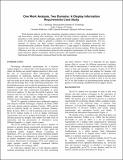| dc.contributor.author | Cummings, M. L. | |
| dc.contributor.author | Tappan, J. | |
| dc.contributor.author | Mikkelsen, C. | |
| dc.date.accessioned | 2014-09-25T20:23:56Z | |
| dc.date.available | 2014-09-25T20:23:56Z | |
| dc.date.issued | 2012 | |
| dc.identifier.uri | http://hdl.handle.net/1721.1/90367 | |
| dc.description.abstract | d observations, among other techniques. Given the time and resources required, we examine how to generalize a work domain analysis technique, namely the hybrid Cognitive Task Analysis (hCTA) method across two domains in order to generate a common set of display information requirements. The two domains of interest are field workers troubleshooting low voltage distribution networks and telecommunication problems. Results show that there is a high degree of similarity between the two domains due to their service call nature, particularly in tasking and decision-making. While the primary differences were due to communication protocols and equipment requirements, the basic overall mission goals, functions, phases of operation, decision processes, and situation requirements were very similar. A final design for both domains is proposed based on the joint requirements. | en_US |
| dc.publisher | HFES | en_US |
| dc.subject | hybrid Cognitive Task Analysis | en_US |
| dc.subject | Work domain analyses | en_US |
| dc.title | One Work Analysis, Two Domains: A Display Information Requirements Case Study | en_US |
| dc.type | Presentation | en_US |
| dc.identifier.citation | Cummings, M.L., Tappan, J., and C. Mikkelsen, One Work Analysis, Two Domains: A Display Information Requirements Case Study, 56th Annual Meeting of the Human Factors and Ergonomic Society, Boston, MA, 2012. | en_US |
